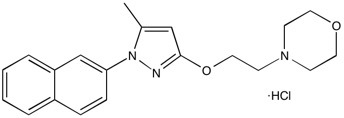S1RA | Selective sigma-1 antagonist
NMR (Conforms)

Available Options
| Size: | Price | Quantity | |
|---|---|---|---|
| 5 mg | $85.00 | ||
| 25 mg | $300.00 |
S1RA (E-52862, 1265917-14-3) is a potent and selective σ1 antagonist with weak binding at σ2 (IC50 σ1 = 17nM, σ2 = 9300nM).1,2 S1RA abolished mechanical and thermal hyperalgesia in mice with carrageenan-induced acute inflammation by enhancing the action of endogenous opioid peptides of immune origin in a σ1 dependent manner.3 S1RA potentiated µ-opioid antinociception in mice in a σ-dependent manner.4 S1RA displayed neuroprotective effects in a mouse model of ischemic stroke.5
References/Citations
1) Romero et al. (2012), Pharmacological properties of S1RA, a new sigma-1 receptor antagonist that inhibits neuropathic pain and activity-induced spinal sensitization; Br. J. Pharmacol. 166 2289
2) Diaz et al. (2012), Synthesis and biological evaluation of the 1-arylpyrazole class of σ(1) receptor antagonists: identification of 4-{2-[5-Methyl-1-(napthalen-2-yl)-1H-pyrazol-3-yloxy]ethyl}morpholine hydrochloride (S1RA, E-52862); J. Med. Chem. 55 8211
3) Tejada et al. (2017), Sigma-1 receptors control immune-driven peripheral opioid analgesia during inflammation in mice; Proc. Natl. Acad. Sci. USA 114 8396
4) Sanchez-Fernandez et al. (2014), Modulation of peripheral μ-opioid analgesia by σ1 receptors; J. Pharmacol. Exp. Ther. 348 32
5) Sanchez-Blazquez et al. (2018), The Sigma-1 Receptor Antagonist, S1RA, Reduces Stroke Damage, Ameliorates Post-Stroke Neurological Deficits and Suppresses the Overexpression of MMP-9; Mol. Neurobiol. 55 4940
NMR (Conforms)
Safety Data Sheet:
Product Data Sheet:
Materials provided by Focus Biomolecules are for laboratory research use only and are not intended for human or veterinary applications. Please note that we do not sell to individuals and that all orders placed by non-research organizations will incur a $20 restocking/refund fee
S1RA (E-52862, 1265917-14-3) is a potent and selective σ1 antagonist with weak binding at σ2 (IC50 σ1 = 17nM, σ2 = 9300nM).1,2 S1RA abolished mechanical and thermal hyperalgesia in mice with carrageenan-induced acute inflammation by enhancing the action of endogenous opioid peptides of immune origin in a σ1 dependent manner.3 S1RA potentiated µ-opioid antinociception in mice in a σ-dependent manner.4 S1RA displayed neuroprotective effects in a mouse model of ischemic stroke.5
References/Citations
1) Romero et al. (2012), Pharmacological properties of S1RA, a new sigma-1 receptor antagonist that inhibits neuropathic pain and activity-induced spinal sensitization; Br. J. Pharmacol. 166 2289
2) Diaz et al. (2012), Synthesis and biological evaluation of the 1-arylpyrazole class of σ(1) receptor antagonists: identification of 4-{2-[5-Methyl-1-(napthalen-2-yl)-1H-pyrazol-3-yloxy]ethyl}morpholine hydrochloride (S1RA, E-52862); J. Med. Chem. 55 8211
3) Tejada et al. (2017), Sigma-1 receptors control immune-driven peripheral opioid analgesia during inflammation in mice; Proc. Natl. Acad. Sci. USA 114 8396
4) Sanchez-Fernandez et al. (2014), Modulation of peripheral μ-opioid analgesia by σ1 receptors; J. Pharmacol. Exp. Ther. 348 32
5) Sanchez-Blazquez et al. (2018), The Sigma-1 Receptor Antagonist, S1RA, Reduces Stroke Damage, Ameliorates Post-Stroke Neurological Deficits and Suppresses the Overexpression of MMP-9; Mol. Neurobiol. 55 4940
Related Sigma Receptors
Download
Calculate the molar concentration, mass or volume in a solution.
Concentration × Volume × Molecular Weight = Mass
Focus Biomolecules • Plymouth Meeting, PA USA • 1-855-FOCUS21
Focus Biomolecules
Plymouth Meeting, PA USA
1-855-FOCUS21
Website Created by Advanta Advertising LLC.

